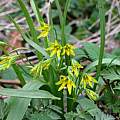The Swabian Jura is an geologically old, and thus rather flat mountain range, in the southwest of Germany with a harsh drop-off to the north west called "Albtrauf" and a soft slope to the south east. It consists mostly of limestone formed in the Jurassic Age, which is rich in fossils from the ever-present Ammonites to exceptionally well preserved specimen of Sea Crocodiles, Ichthyosauria, Pterosauria and even Sea Lily colonies. The porous structure of limestone makes the area unusually dry, as the water quickly drains through the rock, forming extensive cave systems. The local climate ranges from the warm viticultural climate towards the river Neckar, to some high valleys which actually can have ground frost in the midst of summer despite reaching to only about 800 m above sea level.
Poor soils, drought, and difficult climate formed special types of extensive usage typically for the area: orchard meadows in the lower parts and juniper heath-land in the higher regions. The latter one is especially famous for its botanical and insect diversity. The areas need to be kept in shape by roaming shepherds to avoid the return of the original deciduous woodland vegetation. All photos below from Martin Bohnet.
While the area is most famous for its orchids, the non-geophytic subalpine vegetation has its own highlights like gentians, gold, silver and ball thistles, broomrapes and relatives, and many more.
The following species fall into the scope of our wiki:
Allium
Allium ursinum is quite common in the forests of the Swabian Jura and is widely used in local seasonal dishes. Despite the strong garlic smell, there have been fatal misidentifications with poisonous plants in the past, including Convallaria, Arum and Colchicum.
Anemone s.l.
Two species about to be split off into the new genus Anemonoides are quite common spring ephemerals. While the white and sometimes pink A. nemorosa can cover whole forest floors, A. ranunculoides accompanies ditches and streams. Though both can hybridize, I've yet to find such a hybrid in the wild.
Far less common are Hepatica nobilis and Pulsatilla vulgaris, with the former one being another forest spring ephemeral, while the latter prefers juniper grassland in full sun.
Anthericum
Anthericum ramosum enjoys hot and dry habitats in the juniper grassland.
Arum
Despite its name, Arum maculatum has completely spot-free leaves in its Swabian population.
Asarum
Asarum europaeum is a hidden gem in the forests of the Swabian Jura - virtually invisible to those who don't search for it.
Cardamine
Cardamine bulbifera is one of the rare cases of Brassicaceae with a rhizome and even bulbils in the leaf axils. It is common but not abundant in the forests of the Swabian Jura.
Colchicum
Colchicum autumnale flowers in September on the Swabian Jura. It is especially common in orchard meadows.
Convallaria
Convallaria majalis is common all over middle Europe, and is of course also present here.
Corydalis
Together with Anemone nemorosa, Corydalis cava is one of the main spring ephemerals to cover whole forest floors in the Swabian Jura.
Lathraea
While we usually don't have Orobanchaceae on the wiki, Lathraea squamaria fills our description by being a perennial growing from an underground rhizome, even though it additionally connects to the roots of Alder, Hazel or Populus trees via a haustorium. The whitish to pink, short lived flowers are the only evidence of this plant above ground.
Liliaceae
The family of Liliaceae is present with 3 representatives on the Swabian Jura. The tiny Gagea lutea prefers wet areas and slowly recovers from the mistakes of the land consolidation projects of the 1960s as small streams are re-naturalized. The status as a native is somewhat disputed for Fritillaria meleagris which some interpret as a garden escapee from the 17th century.
The most impressive lily on the Swabian Jura is Lilium martagon, which makes a stunning sight in light forests.
Orchidaceae
The orchids on the Swabian Jura include species of three different tribes: the orchidineae, the neottieae and the cypripedioideae. Likewise diverse is their preferred habitat from dark, light-less forests to the blazing heat of south-facing dry grassland slopes.
Anacamptis
Anacamptis pyramidalis flowers towards the end of the main orchid season at the Swabian Jura, around June.
Cephalanthera
The most common species of Cephalanthera in the Swabian Jura is Cephalanthera damasonium, which can be locally abundant and sometimes hybridizes with the less common Cephalanthera longifolia. Even more rare is Cephalanthera rubra. All of them prefer light forest habitats with filtered light.
Cypripedium
Cypripedium calceolus can be found on the Swabian Jura, but the author has still to run into some specimen to photograph.
Epipactis
According to the AHO (Arbeitskreis Heimische Orchideen = committee for native orchids), several species of Epipactis are present on the Swabian Jura - unfortunately the following was already in seed stage to obscure its true species:
Gymnadenia
This genus of small to medium sized, pleasantly scented pink orchids happily hybridizes. On the Swabian Jura Gymnadenia prefers full sun, as opposed to dappled shade in its more southern ranges.
Himantoglossum
Himantoglossum hircinum is the biggest orchid species on the Swabian Jura, and follows the Mediterranean cycle of its cousins with the leaves already withering on emergence of the flower stalk, preparing for the dry summer rest.
Neottia
Species of Neottia have quite a chance of staying invisible to the untrained eye, melting into their green or brown background of their forest habitat - still they are locally abundant.
Orchis
Both subgenera of Orchis are present with their type species on the Swabian Jura.
Ophrys
Ophrys is well known for its interbreeding, which doesn't make identification easy, as there are several species present on the Swabian Jura.
Platanthera
Two highly similar species of Platanthera can be found on the Swabian Jura: P. bifolia and P. chlorantha. Those two can hybridize, so identification once again is difficult.
Paris
Paris quadrifolia is another common forest dweller on the Swabian Jura. Despite the name it sometimes fails to count to four.





































































































